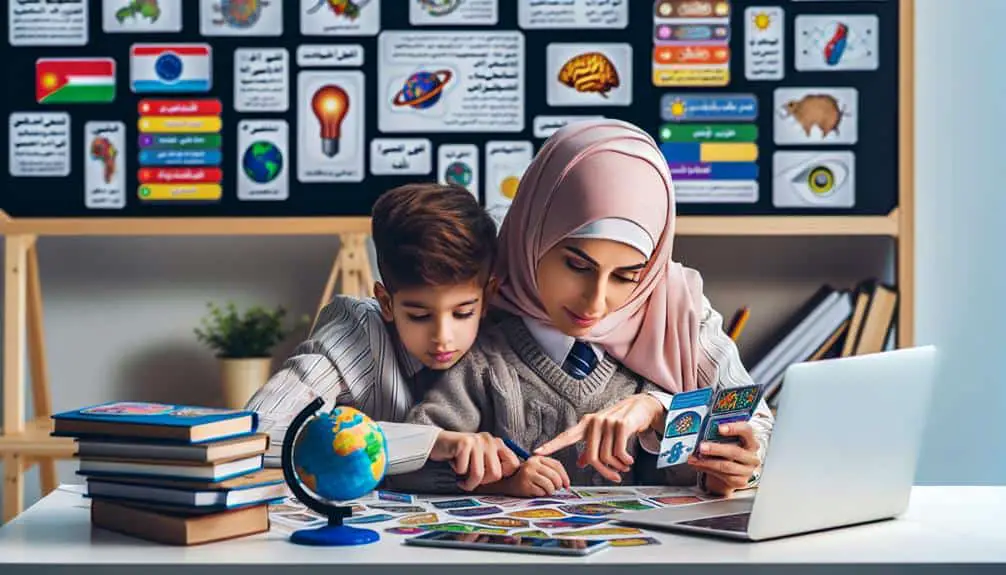In personalizing homeschool learning for individual preferences, understanding unique learning styles is essential. Tailor the curriculum to suit the preferences of visual or auditory learners. Use varied teaching methods like interactive activities and visual aids to engage students effectively. Technology can enhance personalization through interactive platforms and personalized apps. Assess progress regularly to adapt lesson plans based on individual needs. By taking these steps, you can optimize educational experiences for maximum impact and engagement. Keep exploring to uncover more strategies for personalizing homeschool learning in alignment with individual preferences.
Key Points
- Identify dominant learning styles for personalized learning.
- Tailor curriculum to individual preferences for engagement.
- Use varied teaching methods to cater to different styles.
- Utilize technology for interactive and customized learning experiences.
- Assess progress regularly to adjust strategies for optimal outcomes.
Understanding Learning Styles
Understanding learning styles can greatly impact the effectiveness of homeschool learning personalization. People often have a dominant learning style that influences how they best absorb information.
Two common learning styles are visual and auditory. Visual learners comprehend information better when presented with images, graphs, or charts. As a homeschool educator, identifying if your child is a visual learner can allow you to tailor their learning materials accordingly. Incorporating visual aids into lessons can enhance their understanding and retention of the content.
On the other hand, auditory learners thrive on verbal instructions, discussions, and listening to explanations. Recognizing if your child is an auditory learner can help you adapt your teaching methods by incorporating more verbal interactions, audiobooks, or discussions into their curriculum.
Tailoring Curriculum to Preferences
To enhance the effectiveness of homeschool learning personalization, it's essential to tailor the curriculum to match the preferences of the individual student. By customizing activities and utilizing specialized materials, you can create a learning environment that resonates with your child's unique interests and strengths.
- Customized activities: Designing activities that cater to your child's preferences can boost engagement and motivation. For example, if your child is passionate about science, incorporating hands-on experiments or science projects into the curriculum can make learning more enjoyable and impactful.
- Specialized materials: Utilizing materials that align with your child's interests can enhance their learning experience. Whether it's incorporating books on their favorite topics, using educational apps related to their hobbies, or integrating multimedia resources that cater to their learning style, specialized materials can make learning more personalized and effective.
Implementing Varied Teaching Methods
Implementing varied teaching methods in homeschooling not only enhances the learning experience but also caters to the diverse ways in which students absorb information. By incorporating interactive activities and hands-on experiences, you can create a dynamic learning environment that keeps your child engaged and excited about learning. Utilizing visual aids can help visual learners grasp concepts more effectively, while auditory lessons can benefit those who learn best through listening and speaking.
When you vary your teaching methods, you provide opportunities for your child to learn in ways that align with their individual preferences and strengths. For example, if your child struggles with traditional textbook learning, incorporating interactive activities like science experiments or historical reenactments can make learning more enjoyable and effective.
Utilizing Technology for Personalization
Technology plays an essential role in personalizing homeschool learning experiences by providing adaptive resources tailored to individual student needs. Interactive platforms engage learners in a dynamic way, offering a personalized approach to education. These platforms allow students to interact with the material actively, promoting better retention and understanding. Personalized apps cater to each student's unique learning style, adapting content delivery to suit their pace and preferences. This customization fosters a more efficient learning process, enhancing overall comprehension and engagement.
- Interactive Platforms: Engage students in active learning experiences.
- Personalized Apps: Tailor educational content to individual learning styles.
- Adaptive Resources: Adjust content delivery based on student pace and preferences.
Assessing Progress and Adjusting Strategies
Evaluating progress and adjusting strategies involves regularly appraising student performance to tailor educational approaches effectively. Tracking growth is crucial in homeschooling to make sure that each student is advancing academically. By monitoring achievements and areas needing improvement, you can adapt lesson plans to meet individual needs. Utilizing various assessment tools, such as quizzes, tests, and projects, allows for a thorough evaluation of progress.
Flexibility in approach is key when evaluating progress. Not all students learn at the same pace or in the same way. Being open to adjusting teaching methods based on how well a student is grasping concepts can make a significant difference in their learning journey. For instance, if a particular approach isn't yielding the desired results, being willing to try alternative strategies can lead to better outcomes.




